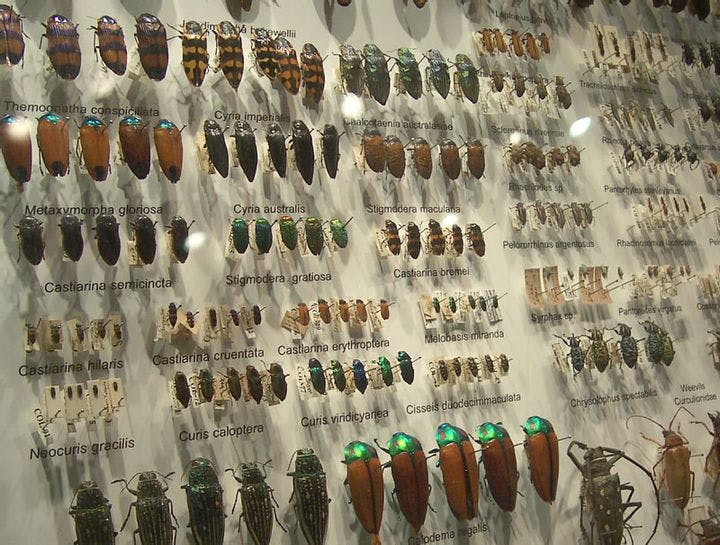Fall 2009
Stalking the Umwelt
– Rob Dunn
The central battle in classifying the world around us is between objective truth and the framework through which we see the world, our umwelt.
Chekhov observed that if you write a story about a man, a woman, and a beetle, the story is always about the man and the woman. Maybe it was an ashtray instead of a beetle. The point is that any story that involves humans is always about the things we do and don’t do to each other. The rest is, if not quite landscape, damn close.
We shouldn't feel bad about caring most about each other. If beetles were writing the stories, they would all be about beetles, perhaps with a giant human foot as threatening landscape. We have evolved senses that are finely tuned to noticing each other and, only secondarily, finding the right fruit and avoiding, for example, venomous snakes. So when it comes to describing the world, we approach the endeavor with a view centered on ourselves, then on animals like us or useful to us. The beetle, even if it lands in our hair, is low on the list.
Nowhere are our biases more consistently problematic than in our struggle to name and categorize life. (Think, for example, of the misguided ladder of progress on which humans are, inevitably, placed on the top rung.) In Naming Nature, science writer Carol Kaesuk Yoon describes the long battle to wrest truth from perception in our attempts to categorize life, from Carolus Linnaeus (1707–78), the forefather of modern taxonomy, to the present day.
Taxonomy—the naming and categorizing of life—is one of the oldest human pursuits. It is the necessary endeavor, an urge even, to distinguish and group the kinds of life so that once named and ordered, they might also be understood. In considering the history of taxonomy, Yoon frames her argument around the narratives of several dozen biologists, more often than not male and an eensy bit megalomaniacal. Their stories are rich and interesting and full of jaw-dropping hubris. Take, for example, Robert Sokal, who in 1953 bet a colleague a six-pack that on a particularly insightful morning he had discovered the new and best way to organize life, based on statistics rather than experience and intuition. He won the beer.
Although scientists drive Yoon’s story, the main character is an “umwelt.” You would be forgiven for thinking that an umwelt was a small bird indigenous to central Europe—the word, though, is ordinarily translated from German as “environment” or “setting,” Yoon’s definition is more nuanced. As she describes it, an umwelt is the world as it is perceived. Every individual of every species has an umwelt. The beetle umwelt is framed primarily by chemical senses. Our human umwelt is visual. Umwelts evolve along with our senses, which struggle to notice the things most relevant to our survival.
Yoon argues that the central battle in taxonomy is between truth—the world as it is—and the umwelt. Historically, humans named the things around them based on what they saw, a dose of local culture, and a set of relatively consistent and near-universal rules (e.g., that each species has a two-word name, whether “fruit fly” or Drosophila melanogaster). Traditional peoples the world over continue to do so. But scientists have sought to devise a true system for categorizing nature. The tension lies in the fact that they do so through senses that did not evolve to find truth. (There is no fitness advantage in looking for truth. In fact, if you look at the reproductive fitness of scientists, there may be some cost . . . ) Instead, we evolved to keep an eye out for sexy cavewomen, predators, or tasty fruits.
Yoon concludes by asking whether there are costs to this quest for truth. Where once taxonomy was based on experts’ experiences and opinions, today it is based on data. Fewer and fewer scientists are well acquainted with the life histories of the organisms they study. They rely on what DNA analyses and computer outputs tell them. Yoon suggests that while these superficially less biased approaches have increased our collective knowledge, they may have done so at the expense of what each of us knows individually. Specialists look through ever narrower lenses at the world in greater and greater depth, even as they believe themselves to be, each day, coming to truer visions of what is out there breeding, feeding, and dying among the weeds. Our ancestors looked at a snake and called it by the name they had given it, a name every child knew. Many biologists today look at a snake and wonder if anyone knows a relevant expert who might be able to identify it.
Naming Nature is rich in insight, characters, humor, and even, yes, truth. The book is almost good enough that if there were a man and a woman in a room with it, the story would still be about the book.
* * *
Rob Dunn is an ecologist at North Carolina State University and the author of Every Living Thing: Man's Obsessive Quest to Catalog Life, From Nanobacteria to New Monkeys (2008).
Reviewed: "Naming Nature: The Clash Between Instinct and Science" by Carol Kaesuk Yoon, Norton, 2009.
Photo courtesy of Wikimedia Commons
